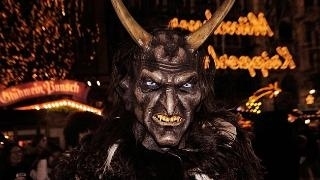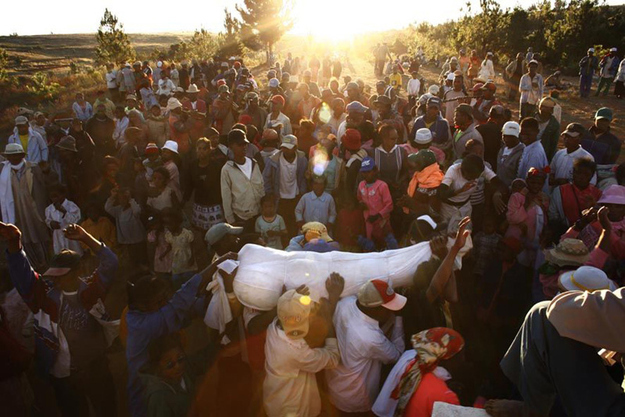These days Halloween consists mostly of disappointing discount shop gimmicks, school dress-up days and house parties.The thrill of the genuine scare and the legitimately creepy are harder to find - but thankfully there are still some places around the world that are doing a great job creeping out both locals and unsuspecting foreigners in ways that don't require cheap props and make-up.
Lets take a tour of the world's scariest festivals.

1. A Krampus Christmas in Germany
Traditionally, you wouldn't expect a demonic hell beast to feature as part of Christmas, but the same country that brought us the Brothers Grimm has managed to introduce the world to the Grinch's older, more homicidal brother and ruin things for everyone.
Meet the Krampus - a half-goat half-human nightmare with a long forked tongue that thrashes bells and chains as he walks. He carries a whip for beating children, and is said to capture naughty children, stuff them into a sack and carry them off to his mountain lair to be beaten and eaten. To make matters worse, it's Santa himself who gives Krampus the names of children to be taken!
If the story alone wasn't creepy enough, it is still tradition today for men (often drunk) to dress up as the hairy goat monster and run into town carrying torches, rattling chains and bells and screaming at children.
Parents, of course, do the only reasonable thing they can - they let the Krampus imitators into their homes to terrify their children, and later laugh over tea and cake as their children cry in the corner.

2. Day of the Skulls (Dias de los Natitas) in Bolivia
On November 9 every year, the city cemetery of La Paz becomes a popular spot for women to parade their deceased relative's skulls on boxes and pillows and decorate them with flowers and other offerings. They indulge the skulls in the habits that their owner's enjoyed in life, placing a carefully rolled cigarette in their teeth, a colorful beanie on top and a bottle of their favorite alcohol beside them.
This "Day of the Dead" revolves around the Aymara belief held by some Bolivians that humans have seven souls - when a person dies these souls ascend to Heaven, but one is left in their remains on Earth. It is the family's duty to care for and respect the remains in order to honour the deceased and guard against bad luck that may come from neglected spirits seeking attention.
Each year the family returns to their relative's grave and exhumes their remains to take them home and care for them. The tradition is so important that sometimes skulls are bought by families off the black market, or stolen from other graves, and passed off as their own so that they may seek the blessings of the dead.
At sundown the skulls are restored to their homes and the families party all weekend.

3. Attend your own funeral in Spain
Never ones to shy away from the bizarre, the Spanish seemed to have solved the age-old dilemma of "how can I enjoy my funeral if I'm dead?" by holding the annual Fiesta de Santa Marta de Ribarteme every July.
If you're lucky enough to have survived a near-death experience in the last year, you're invited to climb into a coffin and play dead (or try and watch proceedings on the sly) while your relatives carry you into church. If you don't have any family nearby, you'll have the joyous task of carrying your own empty coffin.
After your fake funeral, the procession moves to the cemetery where you are expected to make an offering to Saint Martha to thank her for sparing you from the reaper.
Tourists are forgiven for mistaking the fiesta for an apparent zombie uprising when people start climbing out of dozens of coffins in the town cemetery.

4. Partying with Your Dead Relatives in Madagascar
Like the Bolivians, the Madagascans have a strong cultural attachment to the remains of their forebears, and of course, they like to party with their dead the way every good family should. Every seven years after the deceased's burial, the family returns to the ancestral grave plot to throw a party and exhume the corpse.
This is a celebrated ancient ritual known as Famadihana, or "the turning of the bones". The remains are carried out and the family then dotingly re-wraps the remains in new linen, freshens it up with some choice perfumes, poses for family photos and sits with the body to remember the deceased while elders explain to younger generations the importance of their relatives.
The ancestor is then carried around the tomb by their dancing relatives and re-interred in the family plot with offerings such as money, alcohol and other gifts.
The Malagasy believe that until the remains decompose completely the dead do not leave the living, so families must continue to show their affection, in what can often be a very costly party, until the remains are completely decomposed.
Given the nature of the tradition, there is no specific date for such a celebration other than the requirement that it occurs in the dry season - so visitors might chance on an unexpected party anytime between July and September.

5. Dias de los Muertos (Day of the Dead)
The colourful and popular Mexican Day of the Dead has taken on a life of its own (pardon the pun) outside of Mexico, but the fiesta is actually an invitation from the living to the dead for the spirits of the deceased to return to their living families.
Families prepare an altar in their home decorated with flowers, drinks and food and hold picnics at their relative's graves, which are decorated with flowers and neon lights. Blankets and cushions are provided to make the spirits comfortable, and soap buckets are left out in the living room to help the spirits clean themselves after their long journey to rejoin the living.
This festival features the famous skeleton design known as calaveras, depictions of skeletons doing the everyday activities of the living, from dancing to playing mariachi music, and serve as a light-hearted play with death.
The festival is not meant as an outpouring of grief, but rather as a large communal party where people believe they are partying with the dead. Rave parties fill the streets and large papier mache skeletons parade about in tuxedos and flashy jewellery.
Men and women paint skulls on their faces and put on extravagant costumes to party in a giddy whirl of colour, music and dancing that would make even Baz Luhrmann blush.


